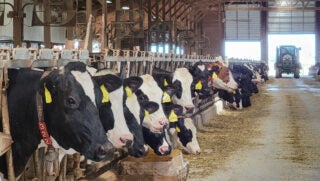Steps to help reduce the occurrence of molds and mycotoxins in your silage and recommendations for restoring dairy herd health.
The year’s corn harvest is fast approaching, but like the growing season itself, it’s at the mercy of Mother Nature. Even in America’s heartland, the effects of hurricanes and flooding take their toll, producing heavy rains that could delay harvest and force farmers to keep their silage corn in the field for a longer period of time. Delayed harvests may lead to altered dry matter status of the forage, which could lead to mold growth and stalk and ear rot; both of which may present the opportunity for mycotoxin contamination.
“There are a number of stressors and diseases, from rots to rusts, that can make silage corn more susceptible to molds, many of which are conducive to mycotoxins,” warns Dr. Lon Whitlow, Professor Emeritus from North Carolina State University. Dr. Whitlow indicates that “Penicillium are often the most common molds found in corn silage because these types of molds are acid-tolerant and have a low oxygen requirement. Moldy silage can be a breeding ground for mycotoxins.”
Once in the silo, oxygen exposure and infiltration is the primary factor that causes silage deterioration. The challenge is that it is difficult to keep air away from drier silages, because dry silage doesn’t pack well and lacks the moisture that helps exclude air. If sufficient air infiltrates the silage, acid-tolerant yeast can flourish. As yeasts grow, they use and deplete lactic acid, allowing pH to rise. At higher pHs, silage becomes a hospitable environment for growth of molds and spoilage bacteria.
The most likely group of resulting mycotoxins under these conditions include deoxynivalenol, zearalenone, and T-2 toxin. When fed in contaminated feedstuffs, such as silage to dairy cows, these mycotoxins are often associated with digestive disorders, intestinal irritation, diarrhea, poor intake, reduced milk production and suppressed immunity.
Fortunately, there are steps producers can take to help reduce the occurrence of mycotoxins in their silage, according to Paulo Rezende-Napier, Mycotoxin Solutions Product Director at Phibro Animal Health Corporation.
Steps to Take to Help Reduce the Occurrence of Mycotoxins in Your Corn Silage
- Harvest corn as soon as possible after maturity.
- Dry corn products to a moisture of 15-18 percent (82-85% DM) and keep cool (less than 55 degrees) to slow fungal growth. For long-term storage, dry to 13-15 percent moisture (85-87% DM).
- Use high-heat drying — when possible — to kill any molds that may be present. High-heat drying is more effective at mitigating molds than low-heat drying.
- Keep storage facilities clean and dry.
- Follow recommendations for good silages — fill fast, pack well, use a fermentation aid and cover with an oxygen barrier.
- In addition to proper drying, organic acids can reduce fungal growth, although any accumulated mycotoxins will still remain in the grain.
Restoring Dairy Herd Health in the Event of Mycotoxin Exposure
What should producers do if they take these precautions yet still notice clinical symptoms in cows fed mold- or mycotoxin-contaminated silage?
“If you observe mold on your corn, it’s best to store it separately,” advises Dr. Dennis Nuzback, Dairy Technology Manager at Phibro Animal Health Corporation. “This avoids contaminating clean feedstuffs and allows you to determine how to best use any damaged corn.”
In the event a producer unknowingly feeds mycotoxin-containing silage to his or her dairy cows, Dr. Nuzback advises to introduce supportive therapies to help mycotoxin-exposed animals remain healthy and productive.
“Because a portion of the mycotoxin is degraded in the rumen, it’s important to support robust fermentation in cows to destroy mycotoxins and minimize toxicity,” Whitlow says. “Absorbent products will help limit the level of mycotoxin damage once ingested by the cow. Immune modulators help to limit the negative effects of prolonged mycotoxin exposure.”


